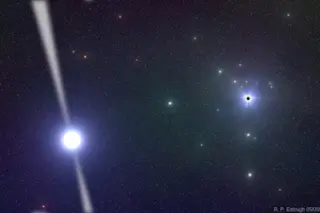A special kind of star named PSR J1745-2900, at left in this illustration, helped astronomers learn that a strong magnetic field exists in the area surrounding the black hole at the center of our galaxy. Credit: Ralph Eatough/MPIfR Even though they're among the most compelling topics to study, black holes are still mysterious to astronomers. Since its discovery nearly 40 years ago, the black hole at the center of our galaxy has eluded most close scrutiny because (unsurprisingly) black holes emit so little light. Luckily, a recently discovered star near the supermassive black hole at the center of our galaxy is now helping scientists learn about these cosmic conundrums’ eating habits.
The star in question, named PSR J1745-2900, is a rare breed of star. When a massive star dies, it can collapse in on itself, resulting in a smaller star made almost entirely of neutrons. When spinning neutron stars emit ...














